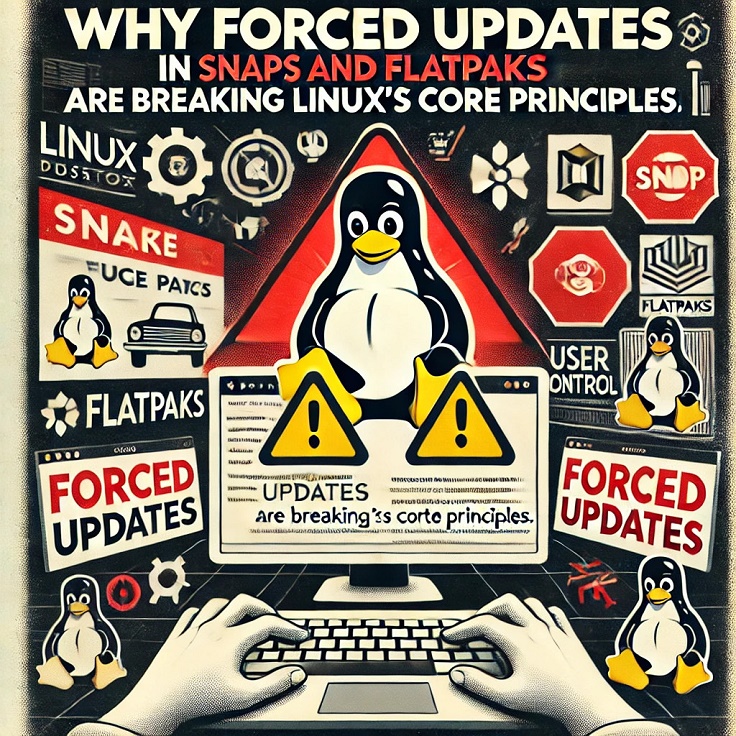Why forced updates in Snaps and Flatpaks are breaking Linux's core principles
Linux has long been celebrated for its commitment to user control and freedom. However, the rise of modern packaging systems like Snaps and Flatpaks, with their mandatory updates, poses a significant challenge to these core principles. This article delves into the implications of forced updates, highlighting how they disrupt user autonomy, compromise system stability, and contribute to the growing concern of vendor lock-in.
User control vs. convenience: The forced updates issue
Traditional Linux packaging systems, such as DEBs and RPMs, prioritize user control, enabling individuals to decide when and how to update their software. In contrast, Snaps and Flatpaks cater to convenience, especially for less technical users, by offering automated updates and dependency management. Yet, this shift raises critical questions about user autonomy.
For many, forced updates can disrupt workflows, especially in environments where system stability is essential. The need to maintain consistent software versions becomes paramount, as unexpected updates may introduce bugs or break compatibility with existing applications.

The downsides of forced updates: breaking the ‘Linux Philosophy’
Linux distributions thrive on the “do one thing and do it well” philosophy. However, Snaps and Flatpaks bundle dependencies together, which, while reducing “dependency hell,” results in larger package sizes and unintended updates. The backlash against Snap’s background updates is telling; users often find themselves unprepared for changes that can occur without prior notice. This lack of transparency runs counter to the traditional Linux approach, where users are empowered to control their systems.
In mission-critical environments—such as servers or development setups—unplanned updates can be particularly detrimental. Users may find themselves scrambling to revert to previous versions after a sudden break in functionality, illustrating the tension between convenience and control.
Security vs. Stability: Striking the balance
Proponents of forced updates argue that they enhance security by ensuring vulnerabilities are patched promptly. However, this perspective overlooks the stability concerns of users who prefer to test updates before implementation. For many, particularly those managing critical Linux systems, the desire to maintain operational integrity outweighs the perceived security benefits of automatic updates.
A well-balanced approach would allow users to review updates, implement testing phases, and ensure compatibility before deploying changes. This flexibility fosters a more resilient system, prioritizing both security and user autonomy.
Bloat and performance issues
Another significant critique of Snaps and Flatpaks is their tendency to create bloat. By packaging all dependencies with each application, these systems lead to larger file sizes and decreased performance compared to traditional package managers. The forced update mechanism compounds this issue, as it continually downloads newer versions, consuming bandwidth and storage space, even when the current version meets the user’s needs.
This inefficiency can be particularly frustrating for those who value a lean and responsive system. As the Linux community increasingly embraces minimalism, the bloat associated with modern packaging systems stands in stark contrast to these ideals.
Vendor lock-in concerns
While Snaps are closely associated with Canonical, the parent company of Ubuntu, Flatpaks are tied to Red Hat and GNOME. This centralization raises alarms within the Linux community, which has historically championed decentralization and user choice. Forced updates can create a sense of dependency on specific companies’ methodologies, eroding the freedom that Linux users have come to expect.
App store mentality: convenience vs. freedom
Snaps and Flatpaks aim to streamline the software distribution process, aligning Linux with the app store models familiar to users of macOS and Windows. While this approach simplifies access to applications, it also detracts from Linux’s foundational principles of user control and customization. The reality of forced updates can feel like a compromise of freedom in exchange for the illusion of convenience.
Potential solutions and middle ground
To address these concerns, developers could consider implementing more granular controls over Snap and Flatpak updates. Options for users to opt-in or opt-out of forced updates could restore some autonomy, allowing for a more tailored experience. Additionally, offering Long-Term Support (LTS) versions of packages could provide users with stability while ensuring that security updates are still accessible when needed.
Alternative package management systems
Other packaging solutions, such as AppImages, provide an appealing alternative by allowing for portable applications without enforced updates. Furthermore, traditional package management systems (like APT or RPM) continue to hold value, especially in scenarios where stability and control are paramount. By examining the pros and cons of these systems compared to newer methodologies, users can make informed decisions about the best approach for their needs.
Conclusion
The debate surrounding forced updates in Snaps and Flatpaks resonates deeply with the Linux community. While these modern packaging systems aim to enhance convenience, they risk undermining the core principles of user control, stability, and decentralization that have defined Linux for decades. As discussions about the future of Linux packaging continue, striking a balance between attracting new users and preserving the values that long-time enthusiasts cherish will be crucial. In a landscape where user autonomy is increasingly challenged, it’s essential to advocate for solutions that empower users rather than constrain them.